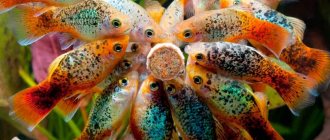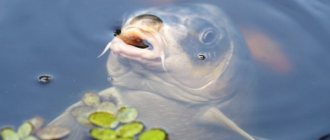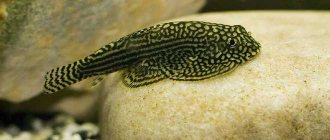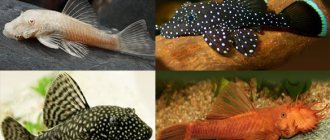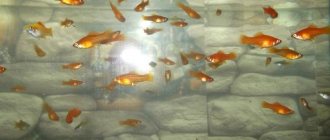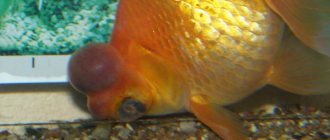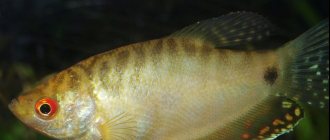Those who decide to have an aquarium at home most often start with peaceful and small fish. It is believed that they are unpretentious and can withstand the tests that inexperienced aquarists will prepare for them. Pecilia is one of these fish. She is not demanding, small and not pugnacious. And how many color options for these aquarium fish there are! Having created heavenly conditions for their life, you can admire these wonderful inhabitants for a long time.
Types of platies
In nature there is no such variety of colors as can be found in home aquariums. Natural platies are dim, almost without spots or contrasts. But there are more than a hundred varieties of aquarium breeds, and they differ not only in color, but also in body shape.
Color options can be listed starting with red platylia. This is the most popular option, and it just doesn’t have a pronounced color contrast. Her whole body is deep red, and her fins are almost transparent.
- Black-tailed - the body color is the same as the red one, and the fins are deep black and slightly larger than those of the standard one.
- Pecilia blue (Tuxedo) - the background of the body is silvery-bluish, and the sides are a rich deep blue color. With good care it grows up to 9-10 cm.
- Pecilia sunset - its body resembles the sunset sky of the Atlantic Ocean or an orange cocktail. The front part of the body is yellow, and from the middle to the tail it turns from orange to red. Quite a rare species, which is highly valued among platies lovers.
- Rizhskaya - there are many small dark spots on a bright orange background.
- Mickey Mouse platie - similar to the red one, but with a distinctive feature: on the tail in front of the fin there are three dark dots: one larger (like a head) and two smaller (like ears), reminiscent of the famous cartoon character.
- Black platylia (schwarz) - its body is completely black, or to be more precise, dark green.
- Neon (rainbow) - transition from head to tail from light pearlescent to black through blue shades. The fins are almost transparent.
- Pecilia tricolor - has a light pink head, then on the body the color turns orange, and the tail is black. It is not known whether the tricolor platie brings happiness, as the tricolor cat does, but it will definitely decorate the aquarium, especially since it is larger than standard sizes, growing up to 7 cm.
They differ in form:
- Black flag platy (velifera) – males have a prominent dorsal fin, somewhat similar to a sail.
- Pecilia radish - its color is similar to the black-tailed one. But the shape of the tail is its own; in the middle there are several rays slightly longer than the rest.
- Pecilia balloon – has a specially created curvature of the spine. As a result, an adult fish has not only an impressive length (up to 12 cm), but also a height (up to 9 cm). She has a prominent belly. These fish are more demanding to keep, as they have weak immunity.
- Pecilia disk - similar to a balloon, but has a less angular body and small size. The color is usually completely red.
- Hawaiian - with different colors, it has a common feature - a large dorsal fin, fluttering like a flag.
Of course, this is only some of the diversity of platies. Considering that all species interbreed well, it is possible to obtain offspring with even more unusual colors than the originals from stores.
In what kind of team will the specialists feel comfortable?
The maintenance of Xiphophorus maculatus requires attention to the correct formation of the team of their “colleagues”. These peaceful and positive creatures are not used to being afraid and hiding. They prefer to feel free and easy. Therefore, you should not choose large aggressive individuals with the character of a predator as companions. They won't be able to resist them.
Catfish that live in the lower layers of water and pick up the remains of food that has settled to the bottom will be good companions.
A cheerful company will form with molynesias, swordtails, guppies and neons. General biological characteristics will play into the hands in matters of nutrition and microclimate formation.
Elegantly swimming calm gouramis and romantic goldfish - veiltails - will not hurt.
A team of turtles is unlikely to be fun. Because, by digging up the sandy soil, they create turbidity in the water and uproot plants.
Unlucky maintenance and rather extravagant appearance make platies welcome guests in any underwater home. If from the moment they move in you surround them with care and love, do not create stressful situations and provide them with adequate food, you can be guaranteed to expect a full range of positive emotions from such joint communication.
Post Views: 4,928
Maintenance and care
To create the ideal home for these fish, you need to start from their natural habitat. Despite the fact that platies bred in captivity on farms are common in our area, their ideal living conditions are close to natural ones. They come from Central America and have taken root well in the southern states of North America. There is warm water with a gentle current, an abundance of vegetation and insects, which the fish feed on.
- The volume of the aquarium is calculated as follows: 1.5-2 liters per fish. Platies are schooling, but thanks to such modest requirements, even a thirty-liter aquarium can look very densely populated (10-12 fish). But please note: the smaller the aquarium, the more difficult the maintenance and care. In a small volume, biological processes occur faster and water deteriorates faster. Even novice aquarists are advised to choose a “jar” of 50 liters or more, and leave the smaller ones as spawning grounds or seed tanks.
- Temperature 24-27°C (it is better to purchase a water heater)
- Hardness 8-25
- Acidity – 7.5-8 (alkaline environment)
- Weekly water changes (quarter volume)
- The soil is preferably fine and dark (including sand). Regular cleaning with a siphon is mandatory.
- Well-established filtration and aeration. If there are a lot of plants in the aquarium, aeration should be minimal, since oxygen oversaturation is also not beneficial for these fish.
- Live plants are highly recommended. They need to be planted so that there is room for swimming.
- The lighting is moderate, only to make the fish look more impressive.
What should the diet be rich in?
When it comes to feeding, the platie is a grateful fish. Its content does not require much effort. Alternating plant and animal feed, the presence of vitamins and microelements in synthetic versions - that’s all that will ensure her health and full functioning.
If you choose live food, you need to grind it quite finely, almost making a paste, since the mouth of Xiphophorus maculatus is quite small. Bloodworms and brine shrimp, small insects and mosquito larvae are suitable. They will be happy to have minced meat, liver or fish, but not more than twice a week.
Feeding
The main diet that will allow the fish to remain alive and active can be dry food. You can choose ones that are designed to maintain color.
But if the goal is to create a real paradise, then it is worth feeding with other foods. First of all, live or frozen bloodworms, tubifex. It is a source of living protein, which means good disease resistance and bright coloring. Vitamins can be prepared from nettles: steamed and finely grated.
The main thing is to remember that in a small aquarium feeding should be done with special care. Any food in excess will quickly spoil the water. It is better to remove uneaten particles of dry flakes, granules, and even more so, the remains of bloodworms and nettles immediately. Platies fish, having an upper mouth, are unlikely to collect food from the bottom. After lying in warm water for a while (an hour or two), it will completely become inedible biological waste. Therefore, feeding should be moderate, so that in 5-7 minutes the fish eat everything without a trace.
Nutrition
Poeciliid fish are unpretentious in nutrition, and happily eat all types of food. It is important that the feeding is balanced and contains both plant foods and live food: daphnia, bloodworms, rotifers, tubifex. Pets are fed twice a day, the amount of serving is determined as follows: food is poured into the water, and how much fish they eat in 10 minutes will be the volume of one serving. Remains of food are removed from the reservoir so as not to provoke the risk of the development of harmful bacteria. Once every seven days, pets are given a fasting day, feeding only plant foods in the morning.
Behavior and Compatibility
All calm fish with similar water requirements are suitable for platies in the neighborhood. These include guppies, swordtails, mollies, and even small cichlids (for example, apistogramma, angelfish and even discus fish, which are preferable to keep in a monospecies aquarium). There are known cases of coexistence with Sumatran barbs in large aquariums: both species are gregarious, and each simply stays in its own flock, without interfering with the lives of others. Danios, tetras, gours and so on are also suitable. The main thing is that the neighbors cannot eat the platy and are not too territorial. And of course, pay attention to the volume of the aquarium. Where there is overcrowding, conflicts are inevitable even between very quiet and peaceful residents.
Aquarium mates
- iris;
- blue, marble and gold gouramis;
- guppy;
- catfish corridors;
- cockerels;
- labeo;
- boots;
- Plecostomus catfish;
- scalars;
- macropods;
- zebrafish;
- mollies;
- bream-like and Sumatran barbs;
- tetras;
- discus.
- African cichlids;
- koi carp;
- South American cichlids;
- astronotuses;
Did you know? If poeciliids are adjacent to swordtails, then they are able to interbreed. The result of such an unusual process may be degeneration of the platies.
Reproduction and breeding
Platies are viviparous. That is, they do not require spawning grounds, a special surface for eggs and other attributes, because the fry mature inside the female and are born as ready-made fish. Pregnancy lasts 1.5-2 months, and what is typical is that the female can bear offspring several times after one fertilization.
Breeding can occur spontaneously in a community aquarium. Then the owner can, at his own discretion, catch the fry and nurse them, or do nothing. The surviving fry, who were not eaten, and who themselves found something to eat, will simply grow up and live happily with their parents.
If you want to engage in breeding at home more seriously, you need a different approach. You can collect a flock of good breeders with bright colors. Create a monospecies aquarium with only platies in it. The fact is that these fish interbreed well with other viviparous fish (for example, with swordtails) and produce viable offspring. Therefore, for the sake of selection, this possibility must be excluded. Special conditions - heating water, shading or bright lighting - are not needed to start the process. It is enough just to take good care of it and feed it with varied and vitamin-rich food. Closer to giving birth, it is better to place a pregnant female in a spawning tank, and as soon as she gives birth, remove her from the aquarium so that she does not start feasting on her own children. Feed the fry with Gammarus, Cyclops and so on. When they get stronger and grow up, you can move them to their parents in a common aquarium.
Fish from the same family:
- Guppy (Poecilia reticulata)
- Limia vittata or single stripe (Poecilia vittata)
- Molly sphenops (Poecilia sphenops)
- Latipin molly (Poecilia latipinna)
- Velifera molly (Poecilia velifera)
- Alfaro turquoise. Alfaro cultratus
- Belonesox belizanus
- Gambusia affinis affinis
- Gambusia affinis holbrooki
- Heterandria bimaculata
- Formosa (Heterandria formosa)
- Ghirardinus (Phalloceros caudimaculatus)
- Girardinus metallicus
- Black-striped Limia (Poecilia nigrofasciata)
- Priapella intermedia
Diseases
How long do platies live in the aquarium of their dreams? Up to 4-5 years. They retain the ability to reproduce for approximately 3 years. Afterwards, they simply live and decorate the space. The diseases are standard, fungal - the kind that can affect an entire aquarium. Treatment is also standard, regular antifungal drugs. The disease occurs with parasites that penetrate under the scales. Such problems can be treated by adding table salt to the water (10 g per 1 liter). Platies tolerate salted water well.
It is important to monitor the water temperature; in cold water, fish’s immunity decreases.
How to choose neighbors?
Platies have a very friendly character. They can easily coexist peacefully with each other and with other fish. As their neighbors, it is better to choose calm, non-aggressive inhabitants of the aquarium with similar temperament and conditions of detention.
Although the platyfish is an extremely peaceful fish, it is best to keep it in a species aquarium with other platy fish, since this entire family prefers hard water, and in the soft and acidic water necessary for keeping characins, the platy will get sick.
- excellent neighbors - fish that prefer hard water: iris, guppies, mollies, swordtails, some types of catfish, etc.;
- if the fish are already accustomed to life in water of medium hardness, then you can add angelfish and some dwarf cichlids, adapted and hardy tetras, Sumatran barbs, zebrafish and gourami to them.
- get along well with eels and aggressive catfish (disagreements may arise);
- absolutely incompatible with all active predators, such as astronotus, cichlids (except dwarf ones) and cold-water species: koi carps, goldfish, etc.
Pecilia panda.
History of gourami
Problems arose from the very beginning with the delivery of this type of fish to European aquarium hobbyists. Caught in Vietnam, Thailand and Malaysia, they were placed in wooden barrels filled to the brim with water. But gourami fish survived in these conditions until the barrels with them were placed in the holds of ships. Fishermen tried to deliver live goods to consumers again and again, but the result was the same - the complete loss of their catch. Not understanding why this was happening, people classified gourami as a problem category and stopped trying to spread it for a couple of decades.
And at the turn of the 19th and 20th centuries, one of the Europeans noticed that under natural conditions these fish from time to time float to the surface of the water to swallow an air bubble. The Indonesian guide advised him to fill the transparent vessels only two-thirds full with water and not seal them. Thanks to such measures, during the transportation of this batch, which included spotted gourami, not one of them died. This happened in 1896.
Gourami also reproduced without problems, so they quickly spread among European aquarists. The first fish of this species were brought to Russia in 1912.
